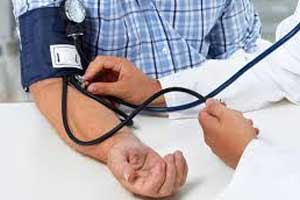- Home
- Editorial
- News
- Practice Guidelines
- Anesthesiology Guidelines
- Cancer Guidelines
- Cardiac Sciences Guidelines
- Critical Care Guidelines
- Dentistry Guidelines
- Dermatology Guidelines
- Diabetes and Endo Guidelines
- Diagnostics Guidelines
- ENT Guidelines
- Featured Practice Guidelines
- Gastroenterology Guidelines
- Geriatrics Guidelines
- Medicine Guidelines
- Nephrology Guidelines
- Neurosciences Guidelines
- Obs and Gynae Guidelines
- Ophthalmology Guidelines
- Orthopaedics Guidelines
- Paediatrics Guidelines
- Psychiatry Guidelines
- Pulmonology Guidelines
- Radiology Guidelines
- Surgery Guidelines
- Urology Guidelines
It's Masked hypertension-High Blood Pressure may not get detected at doctor's office

It may be a case of masked hypertension when High Blood Pressure may not get detected at the doctor's office.
According to an estimate, 20 to 30 per cent of adults in the United States may not be correctly diagnosed with having hypertension due to differences in their blood pressure when measured in their doctor's office versus outside of their doctor's office. The data on masked hypertension have only been published over the past 15 to 20 years, according to Paul Muntner, Ph.D., lead author of the latest scientific statement on blood pressure measurement from the American Heart Association and an epidemiologist at the University of Alabama at Birmingham School of Public Health.
Please also read- Early periods linked to high blood pressure risk
This condition, masked hypertension occurs when people do not have high blood pressure based on readings measured in their doctor's office, but they have high blood pressure readings when measured outside of a clinical setting. Most people have heard of white coat hypertension, a syndrome where one has a high blood pressure reading when taken at the doctor's office, but normal when measured outside of a clinical setting.
"A key take-home message from the new scientific statement is the importance of measuring blood pressure outside of the doctor's office," Muntner said. "Masked hypertension is associated with a high risk for heart disease and stroke. Therefore, it is important that people get their blood pressure measured correctly so they can have hypertension diagnosed and they can get started on blood pressure lowering medications."
The statement outlines ways to accurately measure blood pressure outside of the doctor's office in order to help the physician diagnose hypertension.
"Masked hypertension may be diagnosed through ambulatory blood pressure monitoring, which is when the patient wears a blood pressure cuff for 24 hours and has their blood pressure measured throughout the day and while they are asleep," Muntner explained. "In addition to getting a lot of measurements, this approach allows one's blood pressure to be measured in their natural environments."
More support for 2017 guideline
The 2017 American College of Cardiology/American Heart Association Guideline for the Prevention, Detection, Evaluation and Management of High Blood Pressure, which lowered the blood pressure levels used to define hypertension from 140/90 mm Hg to 130/80 Hg, also included recommendations on how to properly take blood pressure measurements, both in and out of the doctor's office. The scientific statement supports recommendations from the guideline, including using electronic devices, known as oscillometric devices, in clinical settings.
"It is now recognized that these devices are accurate and reduce the risk of human error," Muntner said. "These are new devices that are automated and measure blood pressure multiple times in a row with a single push of a button. The AHA guideline recommends that blood pressure be taken two or more times at the doctor's visit, but we know that is rarely done. The automated devices make it easier to do that."
The scientific statement supports the recommendations on the best way to take your blood pressure, both at the doctor's office and at home.
Blood pressure best practice
For accurate blood pressure readings, you should sit up straight in a chair with a supported back, feet flat on the floor, rest your arm on a solid surface, and not talk to anyone or look at your phone for three to five minutes before the reading is taken. You should also not smoke, drink caffeine or exercise at least 30 minutes before your blood pressure is taken.
People who measure their blood pressure at home should follow the same recommendations.
"Home blood pressure monitoring is very important and is widely recommended for people with hypertension, especially for people who are on anti-hypertensive medication," Muntner explained. "The scientific statement suggests people with hypertension measure their blood pressure two times in the morning and two times in the evening for seven days before each doctor's visit."
The American Heart Association continues to recommend patients measure their blood pressure at home using a blood pressure device with an upper arm cuff that has been checked for accuracy by a health care provider.
For more details click on the link: doi.org/10.1161/HYP.0000000000000087

Disclaimer: This site is primarily intended for healthcare professionals. Any content/information on this website does not replace the advice of medical and/or health professionals and should not be construed as medical/diagnostic advice/endorsement or prescription. Use of this site is subject to our terms of use, privacy policy, advertisement policy. © 2020 Minerva Medical Treatment Pvt Ltd